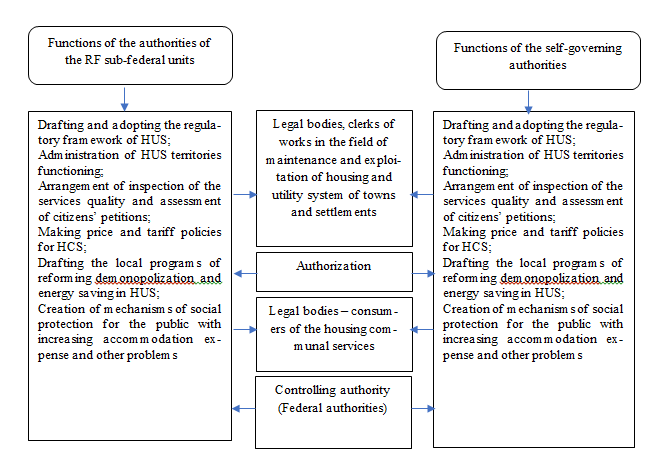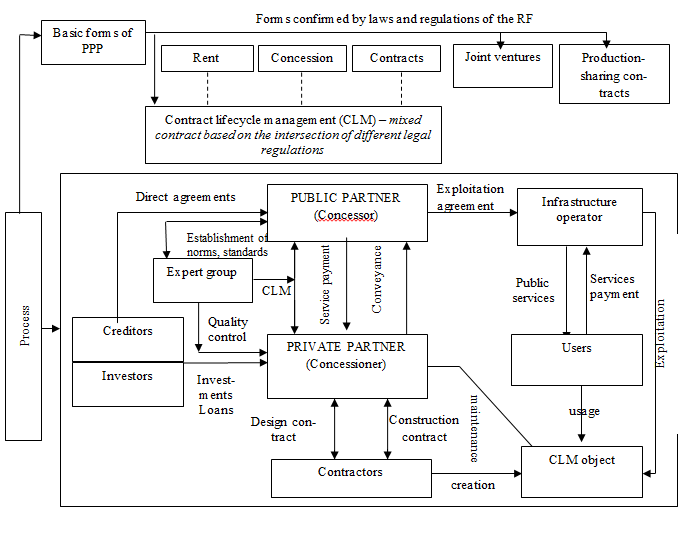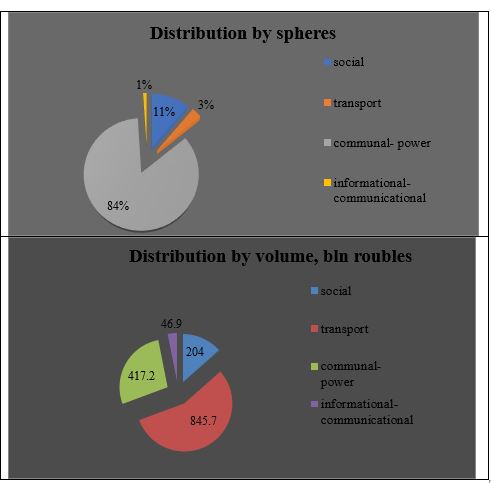Abstract
This article shows the results of the analysis of using the contract lifecycle management (CLM) as one of the instruments of the Public Private Partnership (PPP) in the field of Housing and Utility Sector (HUS). The author focuses on the necessity of using the contract lifecycle management as an efficient instrument of carrying out the projects of the Public Private Partnership in the field of HUS. The novelty of the research involves developing the mechanism of the interaction between the state and the private sector on the basis of PPP and CLM in the field of HUS. In the research the author used the method of analysis of the existing strategies of HUS management, as well as the methods of efficient management in the context of the innovative economic development. On the grounds of the research findings, the following conclusion was drawn – the PPP projects based on the contract lifecycle management can become a real instrument helping to stabilize and improve the situation for developing the innovative investing activities of HUS. The contract lifecycle management is one of the most efficient forms of Public Private Partnership; on the basis of the undertaken analytical and statistical research, the mechanism of administration using the contract lifecycle management is given. Using the common methods of evaluating the efficiency of the Public Private Partnership projects regarding the contract lifecycle management leads to lessening the importance of the social efficiency evaluation and risks analysis, which are extremely significant while implementing this form.
Keywords: Public Private Partnershipcontract lifecycle managementinvestmentsinnovationsHousing and Utility Sectormanagement mechanism
Introduction
Nowadays, the field of Housing and Utility Sector (HUS) is one of the most troubled spheres of the Russian economy, its state worries the scientists and experts. During the period of the social-economic reforms in the Russian Federation, the topicality of the investment support of the innovative processes in HUS field becomes higher. The possibility and quality of solving the existing problems hinges on the degree of soundness of the public authorities’ decisions in the sphere of implemented economic policy of HUS at the regional and municipal levels.
According to the experts’ assessments, the market of HUS in this country is approximately 4.2 trn roubles per year, which makes about 5.7% of the Russian GDP. The volume of the housing stock is 3.3 bln m2, the public service infrastructure of Russia is one of the greatest in the world – the length of the water supply networks is 571000 km, of the sanitation ones – 192000 km, of the heat supply ones – 174000 km (Ham, Van & Koppenjan, 2001).
Problem Statement
The main goal of the performed research is the development of the special form of the interaction of Public Private Partnership which allows spending the RF public funds of the different levels in the best practice way with due regard to the improvement of the investment activity objects quality. This form is considered as the contract lifecycle management, that is, such form where a private investor is in charge of the functional characteristics of the object appearing at the operational stage.
Research Questions
The state via the regional and municipal authorities with the help of the joint partnership with the business structures can avoid the direct budget financing (which is limited to the definite degree) made in the different economic fields and it can use a more advanced model of the private capital procurement under the terms of risks sharing that will allow raising the activity efficiency of every participant of the given interaction form.
In the authors’ opinion, in order to achieve the objective, the further development of PPP in one of the most capital-intensive and troubled industries – building and management of real estate items – should be based on the contract lifecycle management (CLM).
Nowadays there are a lot of methods and mechanisms of fund rising in the economy, they differ in their efficiency, complicated character and in other features.
Purpose of the Study
The main goal of the given research is to develop the theoretical basics of implementing the contract lifecycle management in the HUS field as an advanced form of Public Private Partnership. To achieve the goal, it is necessary to define the key features of CLM, to analyze the main models of management structures interaction at the regional and municipal authorities’ levels. Also the article describes the mechanism of interaction between the state and private sector on the basis of PPP and CLM in the HUS sphere. Besides, the author focuses on the main advantages and disadvantages of PPP for the private sector and for the state.
Research Methods
The comprehensive improvement of the system of innovation management in the field of HUS is a process aimed at the increased level of people’s satisfaction of the housing and utility services. And in this area there is quite a sharp competition and even noted the presence of input barriers (Tsvigun, Novikova, & Zhuravleva, 2003)
Housing and Utility Sector typically has a territorial (municipal) nature and represents a complicated system which fulfils a number of functions that are necessary to support the means of existence of municipalities. That is why the article focuses mainly on the innovative investing development of HUS right at the level of municipalities. Thus, the main tasks of the municipal government in HUS development were determined: 1. creating the conditions for the development of the housing and communal sectors of the municipality economy and increasing the number of the locals having the real estate by increasing the housebuilding volume and developing the financial institutions of the housing market; 2. creating the conditions for bringing the housing stock and communal infrastructure in line with the quality norms ensuring the comfortable living; 3. ensuring the housing availability and communal infrastructure in compliance with the consumer demand of the citizens and the norms of the housing provision.
The solution of these tasks may be supported by implementing the package of the normative, organizing and financial measures. Thus, it is necessary to create the conditions for the competitive business development in the government sphere at the municipal level, to work out the mechanism of interaction with the local authorities and to cultivate the financial institutions in order to attract the investments including the system of Public Private Partnership (PPP).
The key factor of the efficient functioning of HUS is the fast growth of the innovative investing activity which boosts the activity results and quality of the housing communal services. These things give the citizens the feeling of the economic prosperity and safety and they present one of the factors stimulating the economic and social growth of the society (municipalities). This becomes especially urgent given that there is no reliable generalized information on the profitability of management companies in the housing and utilities sector (Novikova, 2016).
For the moment the main task of PPP is to delegate the local and regional authorities the powers to introduce the mechanisms of PPP. In this research, one of the most socially significant economic sectors namely Housing and Utility Sector is paid special attention to.
The pattern of interaction between the administrating authorities of the Russian Federation sub-federal units and local government bodies is shown in Figure

The personal rights of the local government for the solution to the local problems in the field of HUS are defined by National Law № 131 “Concerning the General Principles of the Organization of Local Government in the Russian Federation”. Besides there are some other federal and regional acts, economic legislative acts including codifying statutes (Housing Code of the Russian Federation), articles of municipalities; all of them legally confirm the rights of the local government in the field of HUS.
The analysis of the existing legislation provides insight into the fact that in actual life the rights of the local administering bodies confirmed by the federal and local acts, economic legislative acts, articles of municipalities are much broader than the rights covered by Article 17 of the National Law “Concerning the General Principles of the Organization of Local Government in the Russian Federation”. At the same time, the list of questions of local significance cannot be expanded by the adoption of legal regulations conferring the additional powers to the local governments in any field, as it contravenes Art.18, para.1 of the given Law.
The most important factors slowing down the attraction of investments to the potential-appealing market of HUS are: 1) lack of the balanced and predictable strategy of pricing and subsequently the high potential risk of the money loss or of the payback period extension; 2) lack of the warranties on the part of the state and local governments that may confirm the full discharge of the budget obligations towards Housing and Utility Sector; 3) the high rate of receivables and payables of HUS enterprises and organizations and subsequently their unstable financial standing.
So the measures aimed at stimulating the innovative investing processes in HUS will not produce any significant results while this industry is non-competitive at the capital market. The greater focus should be placed on the development of the income base of HUS and reduction of the investments risks.
The basic forms of PPP are shown in Figure

This article focuses on one of PPP forms that is considered by the authors as the most efficient - contract lifecycle management (CLM). Despite the fact that the form of CLM is regarded as one of the traditional forms of PPP in Russia it is distinctly different from the well-known and widely-used PPP forms in the Russian Federation (Tang, Shen, & Cheng, 2013).
On the basis of PPP and CLM, the original model of the interaction mechanism between the state and business was created (Figure
The given mechanism includes the basic elements of PPP, the process of making of CLM; there is a special group - expert group controlling the quality of works, compliance with standards and norms defined by the contract which will help to minimize the concessor’s risks.
Contract lifecycle management can be defined as a form of PPP contract whereby the public partner makes an agreement for designing, building and exploiting the object for the period of the object lifecycle by tender. Then the public partner pays for this project in equal parts after putting the object into operation on the condition that the private partner maintains the object in accordance with the given functional requirements (Rementsov, 2016).
The given definition makes it possible to determine the key features of CLM that differ this form of contracts from the other contract mechanisms of PPP used in Russia:
this contract covers all three stages of the object lifecycle – designing, building, exploiting;
for CLM the private partner makes all the designing and technical decisions that are necessary for implementing the innovation project independently and he/she bears all the technical risks and the risks of the design projects;
payment for the project is made as an annual (or quarterly) “payment for services” and depends only on the fulfillment of the contract functional requirements (Autant-Bernard, Fadairo & Massard, 2013). Otherwise a special design company is fined as enacted by the contract;
CLM does not cover the tasks of operating that is tolling for the usage of the infrastructure object. Payments for the services rendered to the state depend only on the object quality (Blanc-Brude, Goldsmith, & Välilä, 2006);
propriety rights for the housing and communal services may belong both to the public party and the private one – according to the specificity of the given innovation project;
the public partner’s payments for the services should be secured during the whole contract period.

The situation becomes even more serious as the investors may have no money, the lending resources are very expensive and the offered projects may have low yield. Upon such conditions, self-liquidating projects become the most attractive ones for the investors. The distribution of PPP amount from the perspective of infrastructure spheres and investments volume is represented in Figure

The diagrams show that the public expenses during the budget financing significantly exceed the public expenses while using CLM mechanism. It is conditioned not only by the fact that in CLM projects the business partner covers a definite share of expenses but also by the reason that the business partner guarantees that the building will be constructed in time and in compliance with the contract requirements; otherwise he/she will bear losses because of the violation of the contract. So the practice of the foreign countries shows that CLM form helps to reduce the time of construction and to decrease its cost price up to 40% (Tang, Shen, & Cheng, 2013).
To introduce CLM projects, one needs large stable companies able to carry out the whole cycle of works from the investment feasibility study to the technical maintenance of the object. They should have employers able to apply the innovative methods of designing, construction and maintenance and to ensure the quality level stated by the contract.
It is the contract clause stating the key characteristics of the object that will influence the investments payback and profit margin of the business partner, as the great diversity in the expenditure side is caused by the public purchases.
Let us consider the advantages and disadvantages emerging during the usage of PPP instruments both for the public and for business (Table
The interest of the Russian and foreign investors in PPP projects based on CLM in HUS sphere is explained by the investors’ possibilities to pour their capital into the stated objects for a long term and to get the secured stable payback revenue during several years. In addition, do not forget that the implementation of the PPP project increases the gross regional product, tax deductions to the budgets of the federal, sub-federal and municipal levels, will allow to solve social problems Elkina, & Isaev, 2016).
Thus, it is necessary to improve the regulatory and legal framework as it does not meet all the requirements of implementing the innovative investing projects in HUS sphere on the grounds of PPP
Findings
For the efficient functioning and implementing the large-scale projects, it is necessary to take a series of steps at the federal, regional and municipal levels. One of the conceptual problems is the improvement of HUS management during the interaction of the public and private partnership (PPP) as well as the development of the innovative investing activity.
In the authors’ opinion, the most efficient form of the innovative investing activity development in the HUS field is CLM. Let us outline the main advantages of this form:
planned use of funds by the public;
minimization of the project risks both for the public and for the private business;
the guaranteed project handover in the terms confirmed in the contract, otherwise, there are fines;
the public compliance of the social commitments to the society;
the possibility to reduce pricing and tariff policy.
The given mechanism of management is an efficient means of stimulating the expansion and renewal of the key assets and innovative investing activity.
Conclusion
In the first place, the usage of PPP mechanisms can allow implementing the socially significant projects within the shortest time, though such projects are not attractive for the traditional forms of private financing including the sphere of HUS. It also helps to reduce the load on the budgets of different levels and to increase the project efficiency due to the private business’s participation.
The domestic and foreign practices show that the PPP model based on CLM is efficiently used in the sphere of HUS. This result is caused by the fact that the lifecycle of HUS meets the requirements of CLM parties regarding the conditions of financing, payback, construction and maintenance of objects.
References
- Autant-Bernard, C. Fadairo, M. & Massard, N. (2013). Knowledge diffusion and innovation policies within the European regions: Challenges based on recent empirical evidence. Research Policy, 11, 196–210.
- Blanc-Brude, F., Goldsmith, H., & Välilä, T. (2006). Ex Ante Construction Costs in the European Road Sector: A Comparison of Public-Private Partnerships and Traditional Public Procurement, EIB Economic and Financial Report, 01, 33-41
- Elkina, N.V., & Isaev, D.L., (2016). Formation of the mechanism of public-private partnership in the housing construction industry. Baikal research journal 7, 4
- Ham, H., Van, & Koppenjan, J., (2001). Building public-private partnerships: assessing and managing risks in port. Development. public management review, 3, 598-604.
- Novikova, N.G. (2016). Investigation of the factors of competition development in the sphere of housing stock management. Izvestiya Baikalskogo State University, 26, 6, 955-963
- Rementsov, A.A. (2016) The Role of the Public and Private Sector in Russian Transport Infrastructure. Science Journal of Transportation 7, 41-47.
- Tang, L., Shen, Q., & Cheng, E., (2013). A review of studies on Public–Private Partnership projects in the construction industry, International Journal of Project Management, 28, 683-694
- Tsvigun, I.V., Novikova, N.G., & Zhuravleva, O.V. (2003). Approaches to the analysis of entry barriers in the formation of a competitive environment in the sphere of housing and communal services. Izvestiya of Irkutsk State Economic Academy. 2 (35), 12-17
Copyright information

This work is licensed under a Creative Commons Attribution-NonCommercial-NoDerivatives 4.0 International License.
About this article
Publication Date
17 December 2018
Article Doi
eBook ISBN
978-1-80296-049-5
Publisher
Future Academy
Volume
50
Print ISBN (optional)
-
Edition Number
1st Edition
Pages
1-1464
Subjects
Social sciences, modern society,innovation, social science and technology, organizational behaviour, organizational theory
Cite this article as:
Timchuk, O., Grigorova, L. Y., & Vihoreva, M. V. (2018). Topical Usage Of Contract Lifecycle Management In Housing And Russian Utility Sector. In I. B. Ardashkin, B. Vladimir Iosifovich, & N. V. Martyushev (Eds.), Research Paradigms Transformation in Social Sciences, vol 50. European Proceedings of Social and Behavioural Sciences (pp. 1169-1178). Future Academy. https://doi.org/10.15405/epsbs.2018.12.143

